Curriculum Blog
Code Week EU 2020
In just over a week Code Week EU 2020 starts, EU Code Week is a grass-root movement run by volunteers who promote coding in their countries as Code Week Ambassadors. Anyone – schools, teachers, libraries, code clubs, businesses, public authorities can take part.
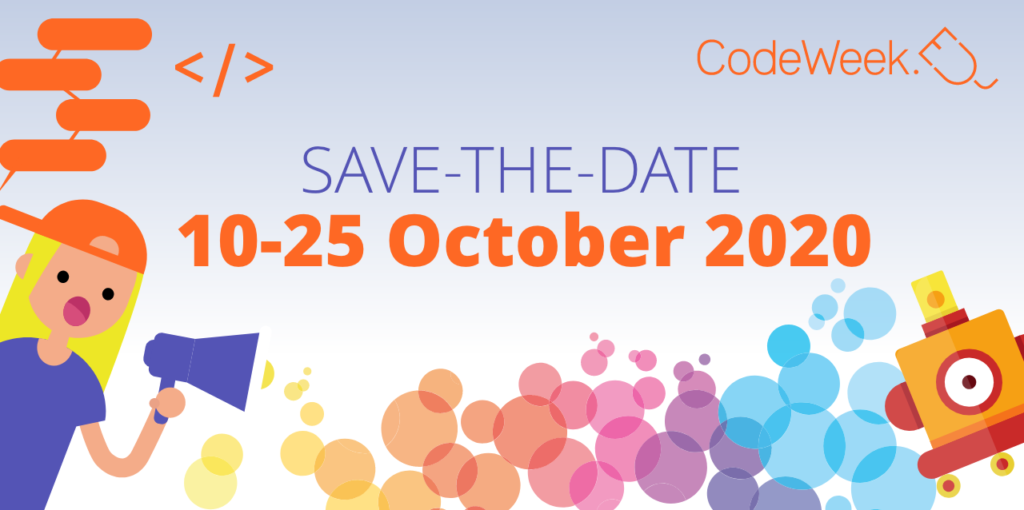
Coding is for all, not just for programmers. It’s a matter of creativity, of computational thinking skills, of self-empowerment, nothing boosts your problem-solving skills like learning how to program a computer, learning to code boosts your attention to detail, having a high level of focus can improve any part of your life!
Our National Curriculum computing programmes of study tells us “A high-quality computing education equips pupils to use computational thinking and creativity to understand and change the world” Coding isn’t just the act of programming code to control a device, it’s about being able to identify and understand problems or needs in the real world and using innovative thinking and creativity alongside logic reasoning to improve the world around them.
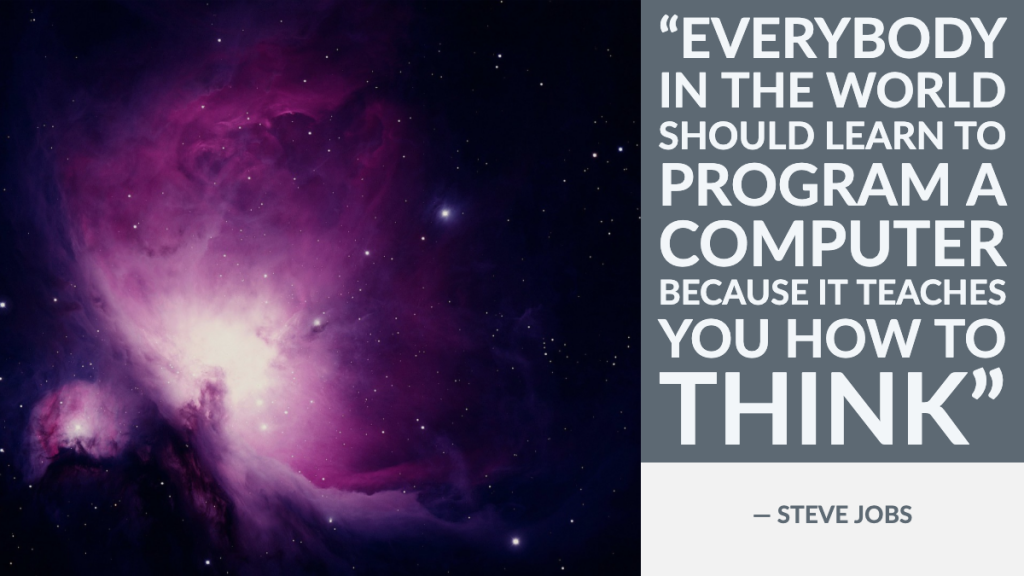
Computing is about teaching students about what is behind their screens and boxes and how the modern world works. With this knowledge, they can begin to see the possibilities so that they can create innovations that could one day change the world.
If you are interested in bringing coding to your classroom but you don’t know where to start, do not worry as we have plenty of LGfL award-winning Energise curriculum content via our Computing resource page, that can invigorate your teaching of computing.
As a Learning Resource Consultant alongside my general responsibilities, I also have the role of leading computing for LGfL. Many computing subject leaders tell me they need more support in getting Computer Science into an already bursting timetable, need support with upskilling teachers skills and more help with providing resources that support teachers understanding of the computing curriculum. I am very happy to provide two new resources that have been designed to support computing leaders and the subject of computing in primary schools.
Firstly, we have Spotlight on Computing a resource which “glues” together resources found in the Energise LGfL award-winning portfolio of curriculum resources. Computing Spotlight is not a scheme of work but has been designed as a way of introducing core concepts and to help teachers and students understand the basics of computing with simple to follow lessons.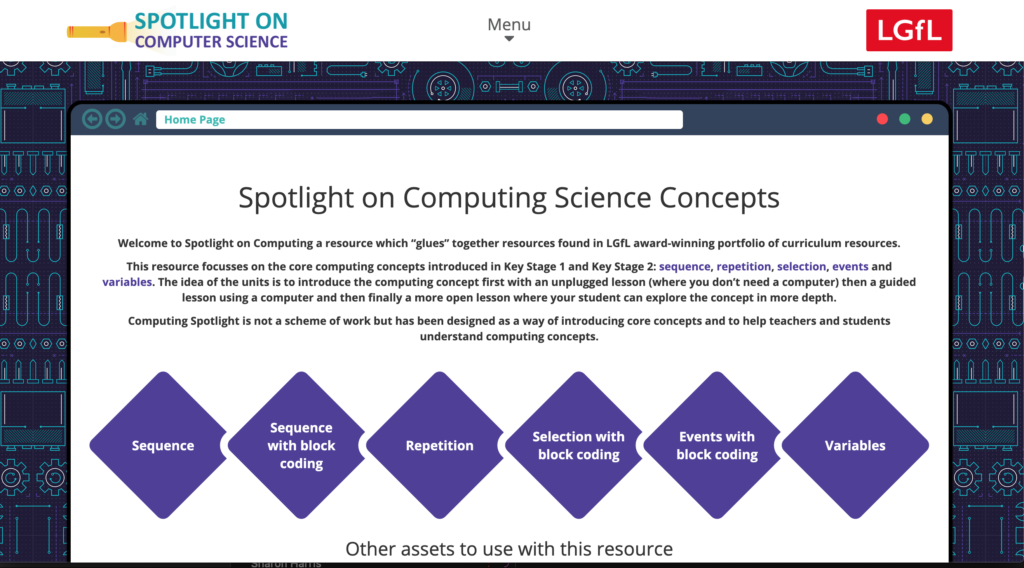
This resource focusses on the core computing concepts introduced in Key Stage 1 and Key Stage 2: Sequence, Repetition, Selection, Events and Variables. Each unit has three lessons made in Powerpoint and provides an idea to form the fourth lesson.
The idea of each of these units is to introduce the computing concept first with an unplugged lesson. Unplugged coding aims to teach programming concepts through the use of games or activities that can be done offline using tangible objects, such as paper and marker pens. The activities allow children to participate in kinesthetic opportunities that help them relate the concepts they are learning in their own lives.

The next part is a guided lesson using a computer and focuses on using Busy Code found in Busy Things The students are introduced to coding and taught the fundamentals of how to create, run and debug simple programs. In other words, they can have lots of fun making Busy Things’ Beard Man walk and dance!
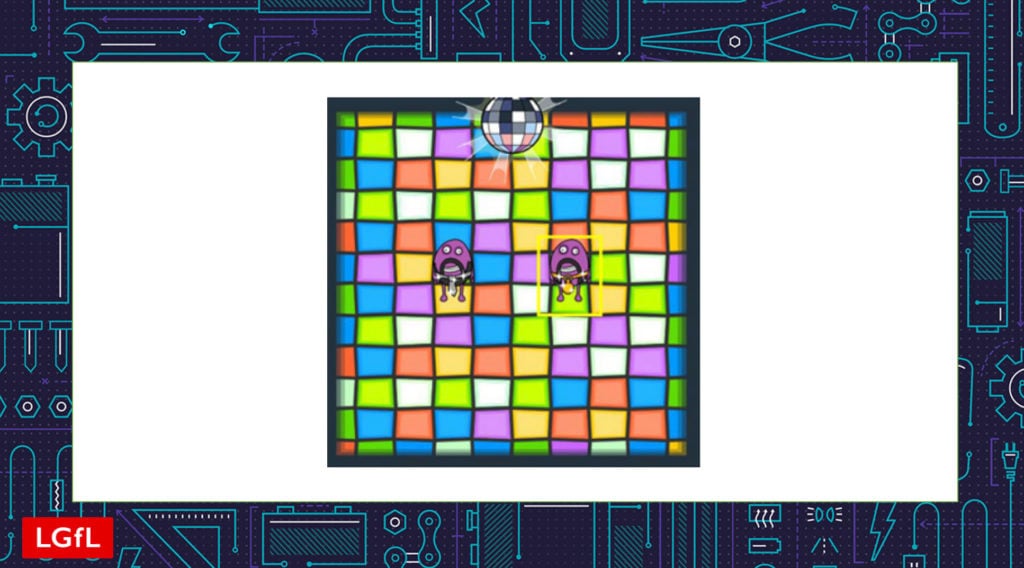
Code Disco is a great way for children to learn coding basics through to repeat loops, conditionals, events and variables. The programs are built by linking simple blocks together, with an easy to use drag and drop feature.
The lessons are broken down into three parts and are scaffolded, supportive and perfect for beginners to block coding.
Tutorials – simple and fun – introducing new programming concepts step by step.
Challenges – children are given problems to solve using the concepts that have been introduced in the tutorials.
Projects – open-ended tasks that let children experiment with the concepts they have learnt; allowing them to be creative and see how the changes they make can alter the program.
The third part of the unit is a more open lesson where your students can explore the computing concept in more depth using the J2e Toolsuite coding platform j2code. This award-winning coding resource offers four differentiated platforms; within Spotlight on Computing we focus on two parts of the j2code platform:
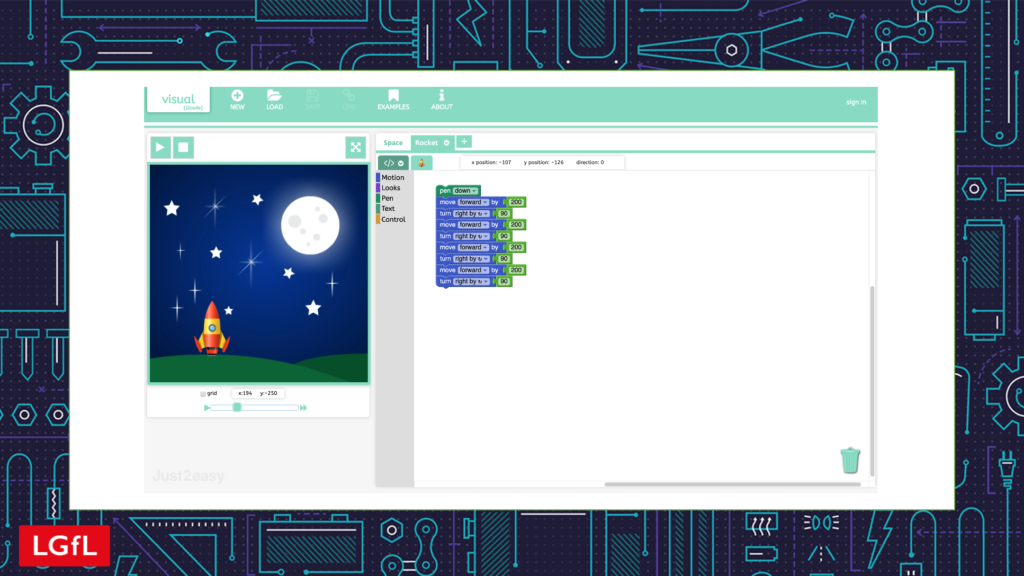
JIT Turtle is aimed at the youngest learners and starts to introduce all of the important concepts of programming and is used in the first lesson in the Computing Spotlight. Pupils begin by simply clicking an on-screen turtle or sprite to move it, turn it or put a pen up or down. As well as moving the sprite it builds up a simple program as a series of commands in a separate window. As a user becomes more confident they can move to an advanced mode where the turtle does not perform the actions until the program is run. This is a perfect compliment to motorised floor turtles or other activities
Visual – The visual programming language is a familiar, block-based programming tool. Starting with the simplest of programs, pupils can progress to a high level of sophistication which will keep them engaged and motivated. There are three differentiated levels which enable pupils to work independently without unnecessary clutter and distraction of script that they do not understand or need.
I spoke to Danny Young the Managing Director of Just2easy about the importance of learning to code and children developing digital skills.
“Being digitally literate is becoming increasingly important for the future of our children and Just2easy have 2 offerings to help in that regard, j2code is a set of differentiated coding engines designed for ages 3 to 13, we made sure that there was no need to have software to install and everything is accessed via your USO login. We also designed j2data which offers a different take on digital literacy, focusing on the data aspects, in particular, sorting, filtering and searching data”
In Spotlight at the end of each unit, I have added an extension activity for students to continue to use the particular computing concepts for another lesson which can link to other areas of the curriculum. For example, using Visual and the concepts of inputs in j2code to create an interactive water cycle.
I am also very happy to say our Computing Resource centre is also now online. This page is designed to help computing leaders by showcasing how LGfL resources support the computing curriculum; breaking down our award-winning content into the computing stands of Computer Science, Information Technology and Digital Literacy.

In the resource centre, you will also see a link to other organisations that are passionate about supporting computer leaders and the subject of computing, all of the external links provide outstanding support that is free to use and highly recommended by me.

I know how hard it can be to keep up to date with current computing research so I have added a section in the computing resource centre that showcases research reports that will help build a better understanding of the current climate of computing.

Finally, I have added a video section which showcases the cream of the crop of videos from LGfL TV with videos from our curriculum conferences that hopefully will inspire you to think about computing in a different way.

Looking for a creative way of introducing coding to KS2? Space Adventures is unique and engaging cross-curricular resource based around an original story commissioned by LGfL by the award-winning author Cath Howe.

It features dramatic video content and a virtual reality experience linked to the narrative. The aim is to draw the learner into the turn of events that threatens the ability of our intrepid astronaut Tazz to return safely back to earth. Will her on board computer be enough to get her back safely or will she need to draw on her maths and science knowledge and understanding? The resource features a comprehensive set of resources for Maths, literacy and Science and a Computing unit created my Max Wainwright, author of the popular espresso coding resource for primary schools. There are two units, which are designed to teach computing concepts in line with the Computing Curriculum, Unit 1 is aimed at Year 5 with unit 2 being aimed at more experienced pupils who will have existing coding skills, there are six lessons in each unit. Each lesson contains:
- A presentation that can be used by the teacher with the class on an IWB.
- An introduction video.
- A video demonstrating the code used within the lesson.
- A step by step PDF.
- Extension Activities
- An example of Scratch file for teachers to explore
Python Tutor and Web Tech tutor offers 50 coding projects presented in single simple stand-alone lessons. Students understanding is initially developed at a conceptual level by allowing them to drag and drop parts of the code, but later they can refine their skills with specific code creation in activities.
Students watch a short introductory video. Which presents a key coding concept or problem. They then can carry out a series of related short tasks using the software, after each task is complete, the software will then present the next task in the unit.

When using these resources, it is important to understand that simply using this resource in isolation will not give your students the depth and breadth of computational skills needed to become independent Computational thinkers.
Using and moving code within these resources does create a solid scaffold for students to explore unfamiliar concepts and gives them quick on-screen results but it’s important for students to have the freedom to create code outside of this scaffold, the idea of the resource is not to “copy code” but to gain practical knowledge of key concepts.
It is important to remind ourselves that introducing young people to coding gives them an appreciation of what can be built with technology. Our students are surrounded by devices controlled by computers in their everyday lives. To understand coding is to understand how our devices work, and being able to imagine new devices and services is essential to inspire and push our students to solve the problems of the future, it was with this idea we created ‘History of Computing’

In his forward to History of Computing, Doron Swade (MBE) Formerly Curator of Computing, and Assistant Director & Head of Collections, Science Museum, Tells us:
“The resource promotes the idea that by understanding our digital heritage we can better understand our digital future”
The History of Computing resource features unique materials to help understand how British computing developments have influenced the world we all live in. It also provides a wide range of materials to show how British innovation in Computing Continues to impact on our world today and shape our tomorrow.
The resource features:
- Unique video and photographic resources from the National Museum of Computing at Bletchley Park.
- Expert insight into the iconic British Computing systems from the past 70 years.
- Curriculum material created by practising Computing teachers all mapped out the National Curriculum.
The video materials are used to support a broad range of complete lesson activities to cover Key Stage 2 to 5, however, teachers are encouraged to use and modify the suggested activities and tailor them to the needs of the students and curriculum.
Alongside History of computing, we also have the Women in Computing resource which has been recently updated, WIC promotes the achievements of women in British Computing within the social context of the time, it explores the issue surrounding how and where their unique contributions have developed understanding within the computing industry and wider society.
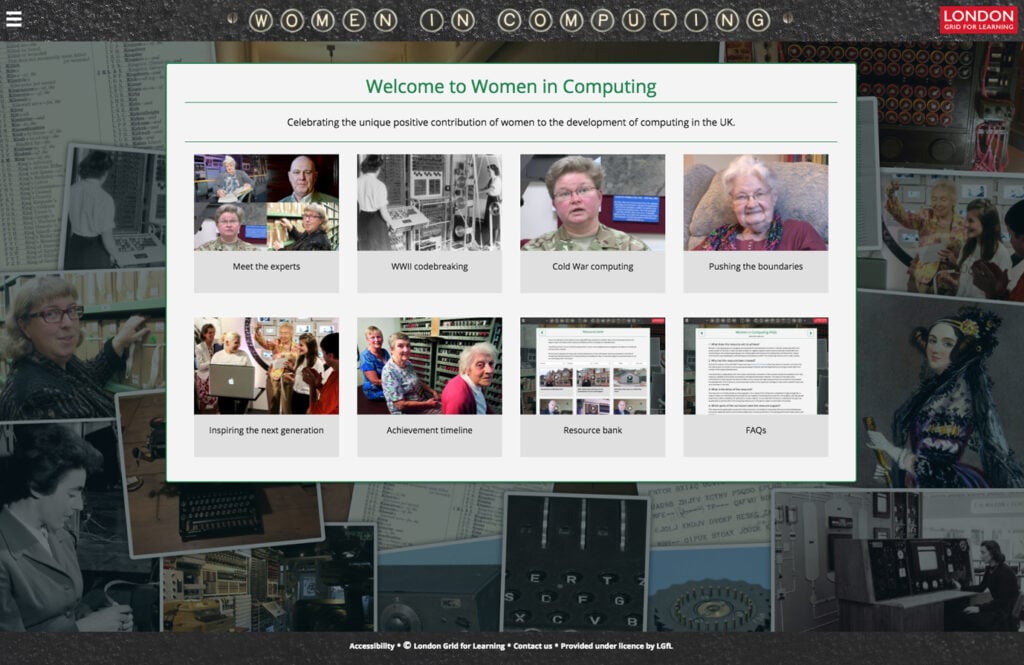
Code week EU have created a range of resources to help you organise and run coding events easier, they have prepared different toolkits and selected some of the best lesson plans, guides and other resources which you can find here.
You could also use the many free resources found within Barefoot Computing Project As Barefoot Ambassador I am proud to help showcase the amazing work the Barfoot team have done creating free resources that will help you improve your subject knowledge and understanding within computing. Barefoot resources give clear definitions, examples and progression across all primary school age and ability ranges.

Barefoot Computing can also help you to deliver the computing curriculum brilliantly with free face-to-face workshops, helpful online guides and engaging lessons. or you can download cross-curricular lessons and resources that unpack computational thinking in almost every subject, saving you valuable time. Barefoot makes computing easy to teach and fun to learn, with or without a computer.
We would love to see how you are going to use LGfL services and resources to help energise your students learning, let us know by sharing your evidence of impact (it could be photos or students work) via our Facebook and Twitter accounts and if we like and retweet your work you could win an LGfL goodie bag!
